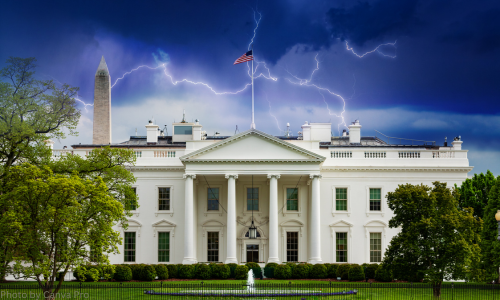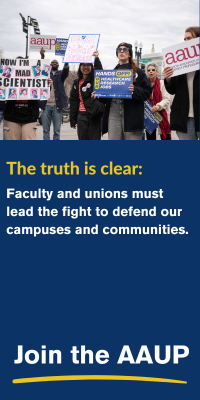- About
- Programs
- Issues
- Academic Freedom
- Political Attacks on Higher Education
- Resources on Collective Bargaining
- Shared Governance
- Campus Protests
- Faculty Compensation
- Racial Justice
- Diversity in Higher Ed
- Financial Crisis
- Privatization and OPMs
- Contingent Faculty Positions
- Tenure
- Workplace Issues
- Gender and Sexuality in Higher Ed
- Targeted Harassment
- Intellectual Property & Copyright
- Civility
- The Family and Medical Leave Act
- Pregnancy in the Academy
- Publications
- Data
- News
- Membership
- Chapters
Trump Is Revealing Our Higher Ed Crisis
Failure to fight the executive orders targeting higher education invites our collective demise.
This article is part of a preview to the spring 2025 issue of Academe. The full issue will be published in May.

This is an introduction to a series of articles focusing on the impacts of the Trump administration's executive orders. See the full list of articles below.
And if you do not hold the line at this crucial moment—this is the moment when you are strongest—you will only get weaker over time.
—Maria Ressa, Filipina journalist and Nobel Peace Prize laureate
Since Inauguration Day, the Trump administration has waged open warfare on higher education. The speed, scope, and volume of executive orders and agency actions have been overwhelming. If the goal was to create chaos and “flood the zone,” the president has delivered.
The articles that follow—which cover the administration’s assault on federal grant funding; on trans students; on immigration; on diversity, equity, and inclusion (DEI) efforts; and on pro-Palestinian activism—aim to break down and clarify the legal implications of these various executive actions for higher education institutions. The authors explain what the executive orders purport to require, analyze what they actually require, and assess how colleges and universities ought to respond. As these experts ably demonstrate, the legal details matter, and, as with many Trump-world policies, little if any care has been paid to these details.
Yet to understand these disparate actions, we must understand that they are united by a more fundamental aim. Donald Trump is coming for America’s universities and higher education workers for the same reason that Benito Mussolini demanded loyalty oaths in 1931 and Viktor Orbán launched a “vicious smear campaign” against Hungary’s premier university in 2019: Our commitment to open inquiry over propaganda, to persuasion over coercion, to democracy over dictatorship provides a check on authoritarian rule. As Johns Hopkins President Ronald Daniels presciently observed following the Taliban’s attack on the American University in Kabul in 2021, “Independent universities unnerve authoritarians because everything that these institutions strive to achieve is inimical to the autocrat’s devotion to the accumulation and arbitrary exercise of coercive public power.” The Trump administration is not hiding its agenda. In an interview published in The New York Times in early March, for instance, Trump ally and right-wing activist Christopher Rufo situated these attacks within a broader campaign to make universities feel “existential terror.”
With few exceptions, our country’s most powerful and well-funded universities have failed to meet this moment. Call it what you will—“anticipatory obedience,” “voluntary compliance,” “business as usual”—university leaders keep ceding ground in hopes of appeasing an unappeasable threat. Every inch feeds a decades-long right-wing agenda to destroy higher education or capture it for corporate and antidemocratic interests. For anyone with the misguided belief that capitulating to fascists is a smart strategy, the Trump administration’s intent to cut $400 million in federal funding to Columbia University—under the thinnest pretext of “combating antisemitism”—should serve as an overdue wake-up call.
Where do we go from here? We believe that democratizing higher education institutions, and finding solidarity with other prodemocracy movements, will be central to the long and hard fight before us.
Indeed, the failure of college and university leaders to fight back is closely connected to the ubiquity of governance structures that concentrate power within external lay boards of trustees to whom those leaders feel accountable. Particularly when trustees are more likely to have backgrounds in private equity or defense contracting, the autocratic governance structure privileges profit and risk management over human dignity and the educational mission. It helps explain why our most powerful universities, in particular, behave more like Fortune 500 companies than sites of democratic knowledge production.
To save the sector, our institutions must reclaim higher education for the common good. We believe this requires at least three interlocking elements: political education that helps college and university faculty understand themselves as workers in a specific industry (that is, higher education); a more structural understanding and critique of the political economy that shapes decision-making in higher education (for example, where power resides and what incentives are at play); and a positive vision of higher education for the common good (which includes concrete means of democratizing college and university governance by redistributing power to institutional constituents and the communities in which they reside).
With respect to this vision, we are heartened by recent ideas from organizations like Higher Education Labor United (HELU) and Scholars for a New Deal for Higher Education. Scholars for a New Deal has explained how higher education cannot serve democracy and the common good until we unshackle our institutions from the threat of “neoliberal privatization, systems of inequality, attacks on free speech and shared governance, crushing student debt, and deteriorated working conditions for faculty and staff.” They accordingly call for “expanding and redesigning public funding to facilitate free student access and fair and equitable labor conditions in higher education.” We are further emboldened by the rise of faculty organizing—much of it driven by the AAUP’s renewed commitment to build worker power within and across institutions of higher education. Just one example is Labor for Higher Education, a coalition of nine unions led by the AAUP, HELU, and the United Auto Workers (UAW) that has crafted a proactive vision for the sector while also defending it from the Trump administration’s attacks.
As we look to the future, the following series of short articles—published jointly by Academe and LPE Blog, a publication of the Law and Political Economy Project—will help us understand the Trump administration’s war on higher education. One can view each piece as offering discrete analysis that focuses on a specific individual or set of executive orders and agency actions. We would encourage a different approach. We believe the series is better read as a whole, because doing so reveals how seemingly discrete attacks on, for example, science funding, “DEI,” and foreign students bind a common project: to eliminate the institutions and individuals best positioned to resist Trump’s claim to be king. Our colleges and universities are not fighting back. The question is, will we?
Jonathan Feingold is associate professor of law at Boston University School of Law and cohost of the #RaceClass Podcast. Veena Dubal is professor of law at the University of California, Irvine, School of Law and general counsel of the AAUP.
The Assault on Federal Grants by Samuel Bagenstos
The Assault on Transgender Students by Alexander Chen and Dallas Estes
The Assault on Noncitizens by Sarah Sherman-Stokes
The Assault on DEI by Jeremiah Chin
The Assault on Campus Protest by Sameer Ashar



